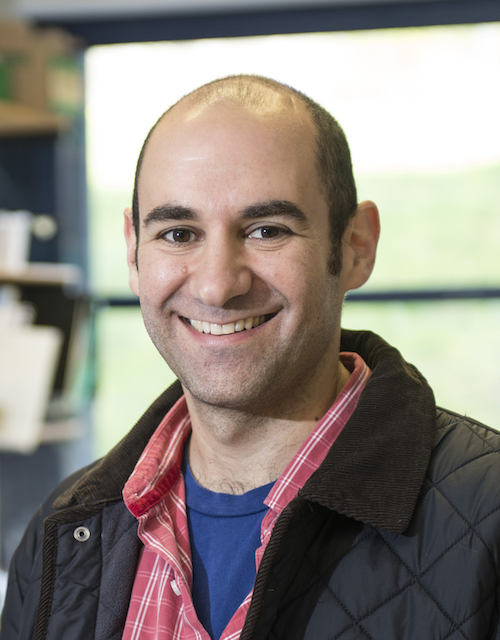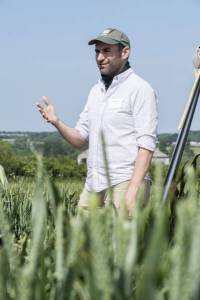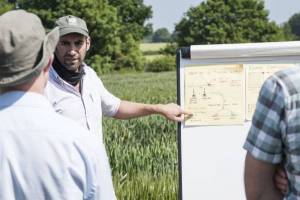Cristobal Uauy research is focused on using genetics and genomics to identify genes involved in wheat productivity traits – such as grain size and shape, pre-harvest sprouting, and resistance to the wheat yellow rust pathogen. With his team, he aims to understand the mechanisms by which these genes function and to translate this knowledge into improved wheat varieties for growers, industry, and consumers.
Cristobal’s team has developed several functional genomics resources to aid wheat breeders and enhance scientific discovery. In particular, they have developed tools and platforms to visualize and implement large-scale datasets into breeding practices.
Cristobal has made significant contributions in map-based cloning of agronomically important genes and in the past years he was instrumental in resequencing the exome of different wheat mutant populations. One of the most impressive aspects of his work is that he immediately develops a tool and browser to make the data easily accessible and usable by the wheat community. In the same spirit, as part of the IWGSC RefSeq v1.0 project, he has led the effort in the IWGSC to gather and integrate all of the RNA-Seq data in a user-friendly platform. Cristobal joined the IWGSC Coordinating Committee in 2016 and has contributed greatly to the discussions regarding the RefSeq and phase II of the consortium.
Please describe your contribution to the IWGSC
My lab has focused on developing tools to accelerate and facilitate the use of data to breeders and other academics. As part of this we developed an open source platform to query published RNA-Seq data and allow users to compare multiple studies without any bioinformatics expertise. As part of the IWGSC, we used both publicly available data and those made available by IWGSC members to analyze 850 RNA-Seq samples and develop a wheat expression atlas. We developed co-expression networks from all these samples and are working to present this data to the community so that they can utilize this data. This analysis also piqued our interest into how the three genomes coordinate expression across tissues and time.
What are the benefits of being part of the IWGSC/International Consortium?
The IWGSC has played a pivotal role in providing high quality genome datasets for researchers to use. An important part of being part of the consortium is that we can coordinate better different initiatives to ensure that the end result is best suited for the community of users. This sometime comes at a cost for speed and there are tensions, but being a member of the IWGSC allows me to work alongside other like-minded scientist to ensure that the final product we deliver is of the highest possible quality and usefulness for the community.
When you started out what were the major roadblocks that you saw to achieving your goals?
My work involves the study of quantitative traits which are notoriously difficult to work with in a polyploid system such as wheat. The major roadblock we face is that many times allelic variation at a single locus leads to a somewhat buffered phenotypic change and hence the phenotypic effects we study are subtle. This makes cloning genes difficult, but at the same time it provides great opportunities to uncover variation which is not available to natural selection. The new genome sequence removes a major stumbling block of the development of physical maps and allows us to advance much more quickly in this discovery phase.
Has your perception changed, and if so what would you say are the major now? How can they be addressed?
We have tried to address other roadblocks such as the need for functional genomic resources and the need for the expression atlas. These are mostly satisfied now and allow hypothesis generation to be acted upon more quickly in polyploid wheat. In my view a major challenge still lies in expanding the repertoire of genes which have a known function. Currently we only have a handful of genes which we focus on and the time is now ripe to move from QTL to genes. The next challenge will be to understand how sets of genes form haplotypes and their effect in breeding and to develop new alleles or allelic combinations to engineer wheat varieties in a more predictive manner.
Will the IWGSC RefSeq genome sequence make a difference to your work? How?
This goes without saying. Having a highly contiguous genome is essential, and equally important is the high quality annotation that is available with the release. This exemplifies how as part of the IWGSC we were able to work with colleagues to ensure synergy instead of competition and we were able to develop and improve gene annotation which builds from previous versions and allows continuity for the research community. Having this reference now allows us to place all our biological and molecular knowledge within a common framework. The RefSeq is the building block for so much more to come and this is extremely exciting.
What more needs to be done to improve the utility of the sequence?
We have to start assigning function to sequence and also start understanding haploype blocks as units of breeding relevance. This is the next step in my view. This will start with re-sequencing of multiple varieties which is already underway and will reveal copy number and structural variation, alongside haplotype blocks within breeding pools. Next will be the understanding of epigenetic marks and how the chromatin context affects gene expression and function. These are all currently ongoing and the RefSeq provides the common anchor in these studies.
The RNASeq database has been a major achievement of your group. How do you envisage it developing and being used in the future?
We hope that the wheat community will make their RNA-Seq data available through the expression website to allow them to analyze their data within a wider context, and also to allow other researchers to use this data for secondary analysis. It is extremely powerful to be able to leverage 850 RNA-seq samples and be able to expand the conclusions of a study with the other 30 or so studies available. The addition of the co-expression networks is an important step to allow us to make sense of these patterns across multiple studies and to develop more informed hypotheses based on wheat data rather than data derived solely from model organisms like Arabidopsis. Importantly, this tool alongside the sequenced mutants, the RefSeq genome, and other resources are ushering in a new cadre of scientist to work on wheat which before they saw as “too difficult”. We now enter a new era where the barriers of entry are lower and this will allow more researchers to impact the field.
What is the best way to achieve translation from genome-based tools to sustainable food supplies worldwide?
This is a big question! Perhaps the philosophy is to ensure that researchers from across the globe are trained and have access to the necessary tools to implement those changes locally. This is critical in wheat were local adaptation is paramount; we cannot simply generate one set of alleles or markers to solve all the issues. However, if we can provide an open-access platform and the associated training to researchers from different parts of the world, then we can ensure that they can implement the latest technologies in situ and address the local problems affecting wheat production. This local knowledge is essential to bring about change and we can help by delivering tools which can be taken up for the multiple purposes of wheat within the local context.
What are your future plans? In terms of research projects, involvement with IWGSC, etc.?
I think that the international wheat community needs to continue coordinating closely and the Wheat Initiative is taking the lead on this. It will be important that we open up as a community to other researchers. They should not be viewed as competition, but rather as partners who enter the field with different skill sets and with the shared interest of making an impact on global food security. I am excited with the influx of new researchers and new technologies into wheat as it makes the transition into a mainstream crop system. I hope to continue working with the international community to make a difference in this field and address some of the questions I outlined previously.
About Cristobal
Cristobal studied Agronomy in Chile and was instantly fascinated by the potential offered by genetics to help address some of the social issues he strongly believed in. During his undergrad studies, he learned more on how molecular biology and genetics could be used for breeding. After a two-month internship at Cornell working on maize genetics, he became convinced by the power of crop molecular genetics. It was an eye-opening experience that made him realize his calling. During his final years in Chile, he focused on crop breeding and then pursued a PhD in wheat genetics at the University of California Davis in the United States.
The excellence of Cristobal’s work has been recognized by numerous awards, among which the Bayer Foundation Early Excellence in Science Award (2012), the Society of Experimental Biology President’s Medal (2014) and, recently, the Royal Agricultural Society of England Research Award (2017).
When he is not spending his time in the lab or in the field, Cristobal is a keen runner and has participated in several marathons over the past two years. A recent highlight was the Vienna Marathon which coincided with the International Wheat Genetics Symposium. With a group of colleagues, he ran the marathon before the main science meeting. A nice way to mix business and pleasure!
Publication date: 01/08/2018



